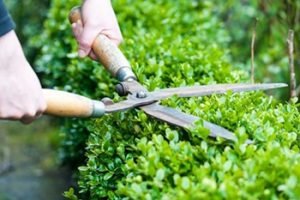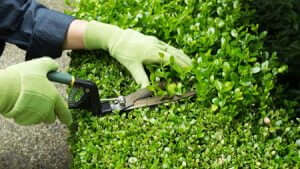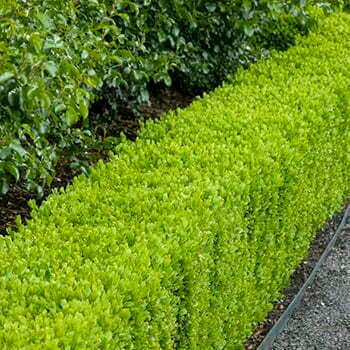A healthy hedge requires regular pruning and watering, a good feeding every now and then and some close-up love and attention with an attentive pruning and mulch or compost helping around the base of the plant.
Why do hedges die, get sick or form unattractive growth:
Old plants
Plants like humans do get weaker and perform less with age, many plants and hedges for that matter reach a point where they simply just don’t look so good anymore and there isn’t much you can do to help them, the best is to rip them out and replace them with new young and strong plants.
Poor maintenance
Poor pruning and neglected watering or feeding are some of the more obvious reasons hedges get out of hand or suffer poor growth. In most cases, a poor performing hedge is the result of poor maintenance.
Diseases and pest infestations
For the most part, hedges are grown from rather robust plants, if kept healthy they should fend for themselves, but like we get sick so do our plants. Most infestations can be reasonably controlled with the necessary products from your nearest nursery or home improvement store. Always make sure you have correctly identified a pest before treating it and strictly follow packet instructions. As always prevention is better than cure.Drought, cold and frost, overwatering or too little light can all be culprits for a sick or dying hedge the list goes on and on.
10 Steps to help and revive a dying, sick or neglected overgrown hedge.
In most cases, a hedge is grown from a fast-growing, but still robust perennial shrub. Most of these can take a hard pruning and come back quite quickly. Depending on the severity of the damage one will need to make a call on replacing the hedge, some of the plants that form the hedge or giving it a hard pruning to reform the shape and health of your hedge.
If your hedge is in a not so healthy or overgrown state, follow these steps and tips to restore its former glory.
Step 1: Evaluate and assess. Pull back the outer branches to access the inner growth pattern and structure of the hedge.
Step 2: Remove any dead and diseased plant material.
Step 3: Nominate poor performing and affected branches and cut them back hard. Ideally, make these cuts where healthy shoots join the branch.
Step 4: Prune off excess growth to encourage air and light movement within the hedge.
 Step 5:
Step 5: In the case of severely overgrown hedges follow the steps above and additionally remove the top third of the plant to around 20 cm beneath the final desired height for the hedge. If more than one third needs to be remove do so over two growing seasons.
Step 6: If entire plants of the hedge have died back remove them and replace with new strong plants.
Step 7: Always feed and water any hedge well after a hard pruning. The hedge needs energy for the encouraging growth from somewhere and with less foliage it is not able to photosynthesis as well as usual.
Step 8: A deep watering less often is always better than shallow regular watering, this encourages a strong deep root system. Regular watering, however, is necessary for a week or so after cutting back.
Step 9: Apply a layer of mulch or compost around the base of each plant to improve soil temperatures and provide nutrients to leach in during watering.
Step 10: Gradually reshape and form the hedge with future pruning throughout the growing season
Tips when pruning and reviving a sick, dying or neglected overgrown hedge:

Keep a close eye on the new growth of your rehabilitated hedge, this succulent new growth is tender and susceptible to fungal and disease infestation. Keep a close eye on your hedge until newly grown foliage is fully hardened.Always feed and water a hedge well after pruning hard and removing excessive plant material.Never add diseased material to a compost heap.
When to prune a hedge:
Only do hard pruning to your hedge during Spring and Autumn. Prune too late and you will encourage new hedge growth which won’t harden off before the cold of winter. Prune too early and the same occurs. Avoid pruning hard in the middle of summer, severe heat and drought will make it impossible for your poor hedge to recover.Light ongoing pruning is encouraged throughout the growing season, cut twigs and branches back to where they meet secondary growth branching from the stem to be pruned.
 Step 5: In the case of severely overgrown hedges follow the steps above and additionally remove the top third of the plant to around 20 cm beneath the final desired height for the hedge. If more than one third needs to be remove do so over two growing seasons.Step 6: If entire plants of the hedge have died back remove them and replace with new strong plants.Step 7: Always feed and water any hedge well after a hard pruning. The hedge needs energy for the encouraging growth from somewhere and with less foliage it is not able to photosynthesis as well as usual.Step 8: A deep watering less often is always better than shallow regular watering, this encourages a strong deep root system. Regular watering, however, is necessary for a week or so after cutting back.Step 9: Apply a layer of mulch or compost around the base of each plant to improve soil temperatures and provide nutrients to leach in during watering.Step 10: Gradually reshape and form the hedge with future pruning throughout the growing season
Step 5: In the case of severely overgrown hedges follow the steps above and additionally remove the top third of the plant to around 20 cm beneath the final desired height for the hedge. If more than one third needs to be remove do so over two growing seasons.Step 6: If entire plants of the hedge have died back remove them and replace with new strong plants.Step 7: Always feed and water any hedge well after a hard pruning. The hedge needs energy for the encouraging growth from somewhere and with less foliage it is not able to photosynthesis as well as usual.Step 8: A deep watering less often is always better than shallow regular watering, this encourages a strong deep root system. Regular watering, however, is necessary for a week or so after cutting back.Step 9: Apply a layer of mulch or compost around the base of each plant to improve soil temperatures and provide nutrients to leach in during watering.Step 10: Gradually reshape and form the hedge with future pruning throughout the growing season Keep a close eye on the new growth of your rehabilitated hedge, this succulent new growth is tender and susceptible to fungal and disease infestation. Keep a close eye on your hedge until newly grown foliage is fully hardened.Always feed and water a hedge well after pruning hard and removing excessive plant material.Never add diseased material to a compost heap.
Keep a close eye on the new growth of your rehabilitated hedge, this succulent new growth is tender and susceptible to fungal and disease infestation. Keep a close eye on your hedge until newly grown foliage is fully hardened.Always feed and water a hedge well after pruning hard and removing excessive plant material.Never add diseased material to a compost heap.





























